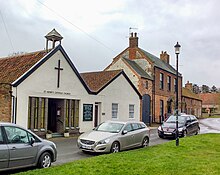Burnham Market

| Burnham Market | |
|---|---|
 St Mary's parish church | |
Location within Norfolk | |
| Area | 18.43 km2 (7.12 sq mi) |
| Population | 877 (2011 Census) |
| • Density | 48/km2 (120/sq mi) |
| OS grid reference | TF834422 |
| Civil parish |
|
| District | |
| Shire county | |
| Region | |
| Country | England |
| Sovereign state | United Kingdom |
| Post town | King's Lynn |
| Postcode district | PE31 |
| Dialling code | 01328 |
| Police | Norfolk |
| Fire | Norfolk |
| Ambulance | East of England |
| UK Parliament | |


Burnham Market is an English village and civil parish near the north coast of Norfolk. It is one of the Burnhams, a group of three adjacent villages that were merged: Burnham Sutton, Burnham Ulph and Burnham Westgate. In 2022, Burnham Market was rated among the "20 most beautiful villages in the UK and Ireland" by Condé Nast Traveler in 2020.[1]
Geography
[edit]According to the 2011 census, Burnham Market had a population of 877 people,[2] which fell to 724 people by the 2021 census.[2]
The parish belongs to the district of King's Lynn and West Norfolk.[3]
History
[edit]
Burnham Market's name is of Anglo-Saxon origin and derives from the Old English for settlement on the River Burn where there is a market.[4]

In 1952, the West Norfolk Junction Railway, which ran through the village, was closed. This railway had linked with Holkham, Wells-next-the-Sea, Hunstanton and Kings Lynn. The station still stands on the road to North Creake.


Burnham Westgate Hall is a Grade II listed country house built in the 1780s by Sir John Soane for Thomas Pitt, 1st Baron Camelford. The Hall was built on the existing Polstede Hall, which had been built in the 1750s by Matthew Brettingham for Pinckney Wilkinson MP.[5]
In 1933, the Hall passed to the Royal British Legion and after the Second World War it was used as an old people's home. From 1990 onwards, it has become the private residence of Baroness Rawlings.[6]
Churches
[edit]Burnham Market is home to several churches.
St. Mary's Church is of Norman origin and is dedicated to Mary, mother of Jesus. St. Mary's was significantly remodelled in the 14th, 15th and 19th centuries and is currently a listed building. The church bells date to the 17th century.[7]
All Saints' Church is of Norman origin and was heavily remodelled in the 14th century, with further minor alterations in the 19th century.[8]
St. Henry Walpole Catholic Church, Burnham Market's Catholic Church, was constructed in 1959 and is dedicated to Saint Henry Walpole, an Elizabethan Catholic martyr.[9] The church conducts weekly Mass on a Friday and Sunday.[10]
Notable residents
[edit]- Anne Elliot – English writer and novelist[11]
- Emma Elliot – English writer and novelist
- Sir Mordaunt Martin – British nobleman
- Sir Roger Martin – British nobleman
- Baroness Patricia Rawlings – British politician and antiquarian
References
[edit]- ^ "The 20 most beautiful villages in the UK and Ireland". CN Traveller. 20 October 2020. Retrieved 11 January 2024.
- ^ a b City Population. (2022). Retrieved November 14, 2022. https://www.citypopulation.de/en/uk/eastofengland/norfolk/E34001083__burnham_market/
- ^ Office for National Statistics & Norfolk County Council (2001) Census population and household counts for unparished urban areas and all parishes. Retrieved 18 October 2005.
- ^ "Key to English Place-names". kepn.nottingham.ac.uk. Retrieved 8 May 2024.
- ^ Zoopla. (2022). Retrieved November 14, 2022. http://content.zoopla.co.uk/8d868de37420be36aa190e87943429e002edea82.pdf
- ^ "An exceptional country estate in Norfolk". Country Life. 2 June 2011. Retrieved 8 May 2024.
- ^ "St-Mary's-Church-Burnham-Westgate - Norfolk Heritage Explorer". www.heritage.norfolk.gov.uk. Retrieved 8 May 2024.
- ^ "All-Saints'-Church-Burnham-Ulph - Norfolk Heritage Explorer". www.heritage.norfolk.gov.uk. Retrieved 8 May 2024.
- ^ "Norfolk Churches". www.norfolkchurches.co.uk. Retrieved 8 May 2024.
- ^ "St Henry Walpole - Burnham Market". Catholic Parish of Walsingham. Retrieved 8 May 2024.
- ^ "Author: Anne Elliot". www.victorianresearch.org. Retrieved 8 May 2024.
External links
[edit]- Map sources for Burnham Market
- Burnham Market Village Plan, with detailed Ordnance Survey map
- Information from Genuki Norfolk on Burnham Market.
